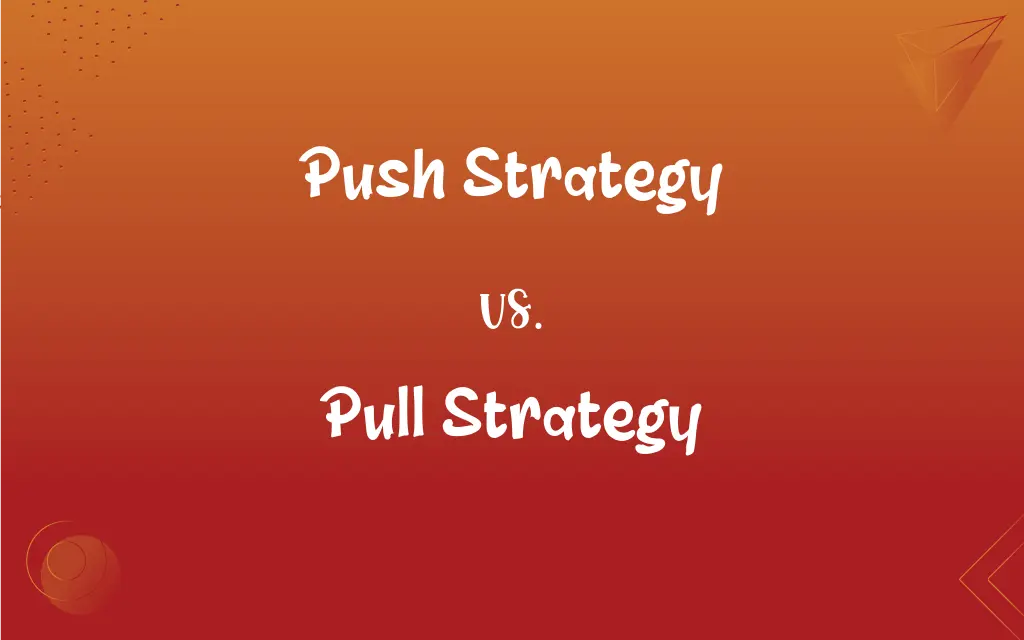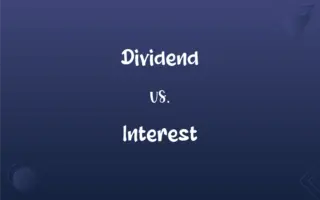Push Strategy vs. Pull Strategy: What's the Difference?
Edited by Aimie Carlson || By Janet White || Published on November 5, 2023
Push Strategy promotes products to intermediaries, while Pull Strategy appeals directly to end consumers to drive demand.

Key Differences
Push Strategy is a marketing approach where companies "push" their products onto retailers or wholesalers to get them onto store shelves. In contrast, Pull Strategy is directed towards the end customers, enticing them to "pull" or seek out the product on their own.
In a Push Strategy, the emphasis is on distribution channels, ensuring that retailers stock and display the product prominently. In a Pull Strategy, the primary focus is on building brand awareness and desire among consumers so that they actively seek the product.
Push Strategy often involves trade promotions, discounts, or incentives to intermediaries. Conversely, Pull Strategy frequently utilizes advertising, public relations, and other forms of direct consumer communication.
A common application of Push Strategy is in industries where there's a new product introduction or where shelf space is crucial. On the other hand, brands with established recognition or those aiming to build direct consumer relationships typically employ a Pull Strategy.
In essence, while Push Strategy works from the supply side, targeting intermediaries to ensure product availability, Pull Strategy starts from the demand side, building and capitalizing on consumer demand.
ADVERTISEMENT
Comparison Chart
Target Audience
Intermediaries (retailers, wholesalers)
End consumers
Focus
Distribution and stocking
Brand awareness and desire
Promotion Methods
Trade promotions, incentives
Advertising, public relations
Application
New product introductions, crucial shelf space
Established brands, building consumer relationships
Origin of Drive
Supply side (product availability)
Demand side (consumer demand)
ADVERTISEMENT
Push Strategy and Pull Strategy Definitions
Push Strategy
An approach involving incentives to facilitate product uptake by retailers.
Using a push strategy, they provided additional margins to motivate retailers.
Pull Strategy
Promotion encouraging customers to actively seek out a product.
The movie trailer was part of a pull strategy, generating significant audience interest.
Push Strategy
A marketing tactic targeting intermediaries to promote product availability.
The company used a push strategy, offering bulk discounts to wholesalers.
Pull Strategy
Marketing directed at end consumers to drive product demand.
Their pull strategy involved a nationwide advertising campaign.
Push Strategy
A method focusing on ensuring retailers stock a product.
Their push strategy involved negotiations for prime shelf space.
Pull Strategy
A technique prioritizing demand side in marketing.
With a pull strategy in place, consumers started asking retailers for the product by name.
Push Strategy
Promotion that "pushes" products onto distribution channels.
The push strategy ensured that the new soda was available in every local store.
Pull Strategy
An approach using direct consumer communication tools like advertising.
Their pull strategy, leveraging celebrity endorsements, proved very effective.
Push Strategy
A technique prioritizing the supply side in marketing.
With a strong push strategy, their inventory turnover rate improved.
Pull Strategy
A tactic focusing on building consumer brand recognition and desire.
Through an effective pull strategy, the brand became a household name.
FAQs
For a new product launch, which strategy, Push or Pull, is more effective?
While both can be effective, Push Strategy is often used to ensure product availability across outlets.
Can a business use both Push Strategy and Pull Strategy simultaneously?
Yes, many businesses use a combination of both strategies for comprehensive marketing.
How important is shelf placement in a Push Strategy?
Very important. Push Strategy often negotiates prime shelf space to increase product visibility.
How does a Pull Strategy generate sales?
Pull Strategy drives sales by building demand and recognition among end consumers.
Which strategy, Push or Pull, is more reliant on advertising?
Pull Strategy is generally more reliant on advertising to create consumer demand.
How does public relations factor into a Pull Strategy?
PR plays a key role in Pull Strategy by building brand image and awareness among consumers.
How does Push Strategy influence retailer behavior?
Push Strategy can offer incentives or discounts to motivate retailers to stock and promote a product.
What's the main target of a Push Strategy?
Push Strategy targets intermediaries like retailers and wholesalers.
Why might a brand prefer a Pull Strategy?
Brands seeking direct consumer engagement or building long-term loyalty often prefer Pull Strategy.
Is Push Strategy more logistics-driven?
Yes, it often focuses on distribution, inventory, and ensuring product availability across outlets.
How does influencer marketing relate to Pull Strategy?
Influencer marketing is a component of Pull Strategy, leveraging popular figures to drive consumer demand.
How do trade fairs and exhibitions fit into Push Strategy?
They're essential, allowing businesses to showcase products to potential retailers and distributors.
Does Push Strategy require more trade relationships?
Typically, yes. Building relationships with retailers and wholesalers is central to Push Strategy.
Is content marketing a part of Pull Strategy?
Yes, content marketing engages and educates consumers, driving demand—a key aspect of Pull Strategy.
Which industries often employ Pull Strategy?
Industries like fashion, cosmetics, and luxury goods often use Pull Strategy to build direct consumer desire.
Can Pull Strategy work without advertising?
While possible, advertising is a potent tool in Pull Strategy to generate consumer interest.
Between Push and Pull Strategy, which focuses more on brand storytelling?
Pull Strategy, as it aims to resonate directly with end consumers and build brand loyalty.
Are discounts and offers more common in Push Strategy?
Yes, especially trade discounts to incentivize intermediaries to promote the product.
How does social media fit into Pull Strategy?
Social media is a powerful tool in Pull Strategy, engaging consumers and driving brand awareness.
Can a Push Strategy be effective without retailer collaboration?
It's challenging, as Push Strategy relies on intermediaries to ensure product availability and promotion.
About Author
Written by
Janet WhiteJanet White has been an esteemed writer and blogger for Difference Wiki. Holding a Master's degree in Science and Medical Journalism from the prestigious Boston University, she has consistently demonstrated her expertise and passion for her field. When she's not immersed in her work, Janet relishes her time exercising, delving into a good book, and cherishing moments with friends and family.
Edited by
Aimie CarlsonAimie Carlson, holding a master's degree in English literature, is a fervent English language enthusiast. She lends her writing talents to Difference Wiki, a prominent website that specializes in comparisons, offering readers insightful analyses that both captivate and inform.
































































